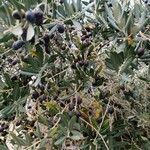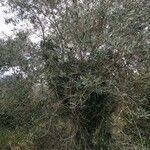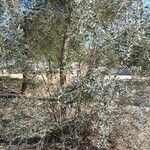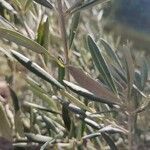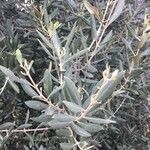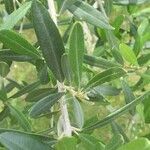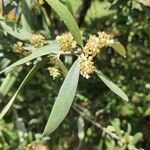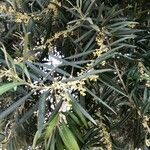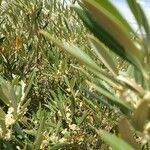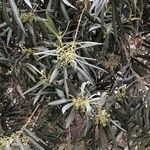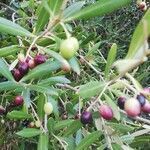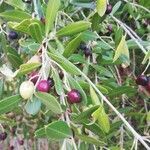Dense bushy shrub or small tree to c. 7 m high; bark becoming rough. Shoots angular, lepidote when young. Lvs shortly petiolate. Lamina 5-11 × 0.8-2 cm (juvenile lvs smaller), lanceolate or narrow-elliptic, sparsely to densely lepidote beneath and appearing pale green or slightly silvery, dark green and lepidote or elepidote above; base attenuate; apex mucronate. Panicles axillary. Calyx 1-1.5 mm long; lobes broad-triangular, glabrous or somewhat lepidote. Corolla lobes 3-4 mm long, whitish, ± oblong, almost fleshy, patent at first, ultimately reflexed. Stamens slightly < corolla. Drupe 5-8 mm diam., globose to broad-ovoid, glossy, becoming red and ultimately black.
Trees or shrubs to 10 m, evergreen. Branchlets angular, along with petiole and leaf blade densely silvery-gray or rusty lepidote. Petiole 2-5 mm; leaf blade narrowly lanceolate to elliptic, rarely narrowly ovate, 1.5-10 × 0.5-2 cm, leathery, glabrous, base cuneate or attenuate, margin entire, apex acute to acuminate and mucronate to cuspidate; primary veins 5-11 on each side of midrib, obscure, somewhat raised adaxially. Panicles axillary or terminal, 2-4 cm. Flowers bisexual or functionally unisexual, subsessile. Calyx 1-1.5 mm. Corolla white, 2.5-4 mm; tube ca. 1 mm; lobes elliptic-oblong, involute, 1.5-3 mm. Drupe ellipsoid or subglobose, 0.7-4 cm. 2n = 46.
Evergreen tree, up to 14 m tall, with warty branchlets. Leaves narrowly elliptic, shiny dark green above, pale greyish scaled beneath. Flowers in loose axillary and terminal panicles, small, white. Fruit an ovoid, purplish black drupe.
Tree to 14 m with warty branchlets. Leaves narrowly elliptic, discolorous, pale-scaled beneath. Flowers in axillary and terminal panicles, white.
